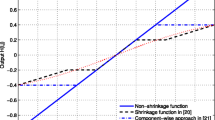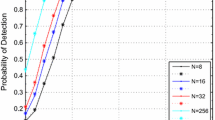Abstract
In this paper, collaborate spectrum sensing with incomplete information is considered, which fully exploits the sparsity of active radios. In the traditional collaborate spectrum sensing, the fusion center is applied to determine the locations of idle channels and a lot of sensing information is required to make decision. Too much information is the bottleneck of the collaborative spectrum sensing applications. Here, two novel efficient algorithms based on matching pursuit are presented. Fusion center is also adopted, but the proposed methods can greatly reduce the quantity of necessary sensing information and obtain better detection performance. Simulations have shown that one has much faster sensing speed and the other obtains better detection accuracy. For 20% primary users are active, the detection probability based on the first algorithm can reach 100% only requiring 64% measurements of the traditional collaborative spectrum sensing.
Similar content being viewed by others
References
Li, Z., Yu, F. R., & Huang, M. (2009). Distributed spectrum sensing in cognitive radio networks. In Proceedings of IEEE WCNC09, Budapest, Hungary.
Ghasemi, A., & Sousa, E. S. (2005). Collaborative spectrum sensing for opportunistic access in fading environments. In IEEE symposium new frontiers in dynamic dpectrum access networks (pp. 131–136). Baltimore, USA.
Visotsky, E., Kuffner, S., & Peterson, R. (2005). On collaborative detection of TV transmissions in support of dynamic spectrum sensing. In IEEE symposium new frontiers in dynamic spectrum access networks (pp. 338–356). Baltimore, USA.
Zhang W., Letaief K. B. (2008) Cooperative spectrum sensing with transmit and relay diversity in cognitive networks. IEEE Transactions on Wireless Communications 7: 4761–4766
FCC. (2002). Spectrum policy task force report, ET Docket No. 02-155.
Islam, M. H., Koh, C. L., Oh, S. W., Qing, X., Lai, Y. Y., Wang, C., et al. (2011). Spectrum survey in Singapore: Occupancy measurements and anlysis. In Proceedings of IEEE CROWNCOM’08, Singapore (pp. 1–7).
Meng, J., Yin, W., Li, H., Houssain, E., & Han, Z. (2010). Collaborative spectrum sensing from sparse observations using matrix completion for cognitive radio networks. In 35th international conference on acoustics, speech, and signal processing (ICASSP).
Meng J., Yin W., Li H., Houssain E., Han Z. (2011) Collaborative spectrum sensing from sparse observations in cognitive radio networks. IEEE Journal on Selected Areas in Communications 29(2): 327–337
Mallat S. G., Zhang Z. (1993) Matching pursuits with time-frequency dictionaries. IEEE Transactions on Signal Processing 41: 3397–3415
Pati, Y. C., Rezaiifar, R., & Krishnaprasad, P. S. (1993). Orthogonal matching pursuit: Recursive function approximation with applications to wavelet decomposition. In Proceedings of 27th annual asilomar conference on signals, systems and computers.
Davis G., Mallat S., Avellaneda M. (1997) Adaptive greedy approximation. Journal of Constructive Approximation 13: 57–98
Tropp, J., & Wright, S. (2009). Computational methods for sparse solution of linear inverse problems. Technical Report No. 2009-01. California: Institute of Technology.
Rappaport T. S. (2002) Wireless communications: Principles and oractice, 2nd edn. Prentice Hall, Englewood Cliffs, NJ
Cotter S. F., Rao B. D., Engan K., Delgado K. K. (2005) Sparse solutions to linear inverse problems with multiple measurement vectors. IEEE Transaction on Signal Processing 53: 2477–2488
Tropp J. A., Gilbert A. C., Strauss M. J. (2006) Algorithms for simultaneous sparse approximation. Part. I: Greedy pursuit. Signal Processing 86: 572–588
Chen J., Huo X. M. (2006) Theoretical results on sparse representations of multiple-measurement vectors. IEEE Transactions on Signal Processing 54(12): 4634–4643
Berg E., Friedlander M. P. (2010) Theoretical and empirical results for recovery from multiple measurement. IEEE Transactions on Information Theory 56(5): 2516–2527
Zhang, Y. (1995). Solving large-scale linear programs by interior-point methods under the matlab enviroment. Technical Report TR96-01. Baltimore County, Baltimore, MD: Department of Mathematics and Statistics, University of Maryland.
Author information
Authors and Affiliations
Corresponding author
Rights and permissions
About this article
Cite this article
Jiao, L.C., Chen, J., Wu, J. et al. Efficient Collaborative Spectrum Sensing with Low Sample Rate. Wireless Pers Commun 67, 923–936 (2012). https://doi.org/10.1007/s11277-011-0419-z
Published:
Issue Date:
DOI: https://doi.org/10.1007/s11277-011-0419-z




